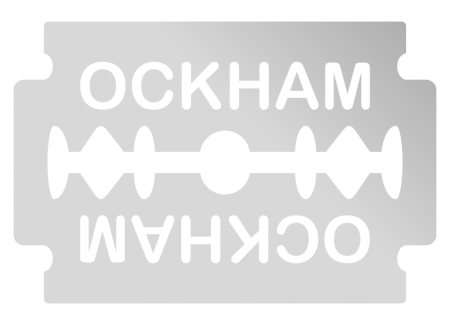
Fake skepticism is a scourge. Yet I enjoy discussions with fake skeptics. Why? The same reason an entomologist studies bugs. To others, bugs are excruciatingly stupid, repulsive and boring but for whatever reason, the entomologist has developed a fascination with them. I have a fascination with irrational people who are convinced that they are rational. Almost as interesting are propagandists that can convince others to believe whatever nonsense they choose.
One of the things that keeps popping up in discussions with pathological skeptics is the erroneous use of Ockham’s Razor. Ockham’s Razor as you might know is the idea that “Entities should not be multiplied without necessity”[1]. In other words, explanations should involve no more assumptions than are necessary. What many pseudo-skeptics have done is butchered this notion into the idea the “the simplest explanation is the best one.” Now it is true that an explanation that avoids unnecessary assumptions is indeed simpler, but there are other important considerations as well. Such a ridiculously oversimplified version of Ockham’s Razor throws out the extremely important aspects of evidentiary support and explanatory power.
Take for example the fall of WTC 7 building on 9/11 2001. For those that don’t know, WTC 7 was a 47 story skyscraper that fell several hours after the Twin Towers came down. There are two basic explanations for the fall of WTC 7, the official story where fire caused the fall and the “conspiracy theory” that the building came down because it was a controlled demolition.
For official story proponents their explanation is “simpler”. The building was on fire therefore fire must have brought it down. NIST did a comprehensive study of the building which says just that[2]. A controlled demolition would be extraordinarily difficult and would involve thousand of people that would eventually talk. They smugly propound that we should appeal to Ockham’s Razor and stick with the simpler explanation.
The overriding problem here is that the official story of the WTC 7 fall has absolutely no scientific evidence to support it. None at all. The only “evidence” ever provided was NISTS’ computer model which looks nothing like the collapse and cannot be examined for errors or fraud because till this day, they refuse to release its data[3]. So we have two glaring purely faith-based assumptions here: 1) that models are accurate even when they don’t look anything like what they are modelling and 2) that NIST did not fudge their model to get the findings they wanted.
The controlled demolition explanation on the other had has several key pieces of evidence to support it. Probably the most important piece of evidence is the fact that the building was in free fall for at least 2.25 seconds. The NIST report has WTC 7 in free fall while it was simultaneously breaking up structure. This is a blatant violation of the law of Conservation of Energy, among others. A falling object has only potential energy to do work. When in free fall, all its potential energy is used to accelerate downward at the rate of gravity. There is no energy available to do other work like breaking up structure. So the third glaring assumption of the official story is that the laws of physics can be violated!
As is clearly evident, those that appeal to Ockam’s Razor as choosing the simplest solution are ignorant of the most basic foundations of science, that explanations must be supported by evidence and evidence that explanations cannot account for or predict, prove that explanation wrong. As we see again and again, mainstream skeptics have a pathological understanding of science, logic and ironically skepticism in particular.
Notes
1. Jonathan Schaffer (2015) What Not to Multiply Without Necessity, Australasian Journal of Philosophy, 93:4, 644–664.
2. NIST NCSTAR1-A: Final Report on the Collapse of World Trade Center Building 7 (PDF). NIST. November 2008.
3. http://911blogger.com/news/2010-07-12/nist-denies-access-wtc-collapse-data.

Michael Fullerton is a software designer based in Vernon BC Canada. His writing explores and exposes pathological skepticism and the corporate pseudo-science it tends to serve. He also has an intense interest in organizational psychopathy, or how psychopaths rise up in organizational structures of all kinds. As a pantheist he strives to be part of the movement to unify spirituality and science.
